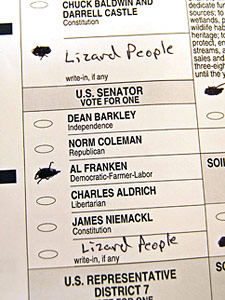Yesterday, I testified before a hearing of Colorado’s Election Reform Commission. I made a small plug, at the end of my testimony, for a future generation of electronic voting machines that would use crypto machinery for end-to-end / software independent verification. Normally, the politicos tend to ignore this and focus on the immediately actionable stuff (e.g., current-generation DREs are unacceptably insecure; optical-scan is the best thing presently on the market). Not this time. I got a bunch of questions asking me to explain how a crypto voting system can be verifiable, how you can prove that the machine is behaving properly, and so forth. Pretty amazing. What I realized, however, is that it’s really hard to explain crypto machinery to non-CS people. I did my best, but it was clear from conversations afterward that a few minutes of Q&A did little to give them any confidence that crypto voting machinery really works.
Another of the speakers, Neil McBurnett, was talking about doing variable sampling-rate audits (as a function of how close the tally is). Afterward, he lamented to me, privately, how hard it is to explain basic concepts like what it means for something to be “statistically significant.”
There’s a clear common theme here. How do we explain to the public the basic scientific theories that underly the problems that voting systems face? My written testimony (reused from an earlier hearing in Texas) includes links to papers, and some people will follow up. Others won’t. My big question is whether we have a research challenge to invent progressively simpler systems that still have the right security properties, or whether we have an education challenge to explain that a certain amount of complexity is worthwhile for the good properties that can be achieved. (Uglier question: is it a desirable goal to weaken the security properties in return for greater simplicity? What security properties would you sacrifice?)
Certainly, with our own VoteBox system, which uses a variation on Benaloh‘s voter-initiated ballot challenge mechanism, one of the big open questions is whether real voters, who just want to cast their votes and don’t care about the security mechanisms, will be tripped up by the extra question at the end that’s fundamental to the mechanism. We’re going to need to run human subject tests against these aspects of the machine design, and if they fail in practice, it’s going to be a trip back to the drawing board.
[Sidebar: I’m co-teaching a class on elections with Bob Stein (a political scientist) and Mike Byrne (a psychologist). The students are a mix of Rice undergrads, most of whom aren’t computer scientists. I experimentally built a lecture that began by teaching just enough number theory to explain how El Gamal cryptography works and how it allows for homomorphic vote tallying. Then I described how VoteBox uses this mechanism, and wrapped up with an explanation of how to do Benaloh-style challenges. I left out a lot of details, like how you generate large prime numbers, or how you construct NIZK proofs, but I seemed to have the class along with me for the lecture. If I can sell the idea of end-to-end cryptographic mechanisms to undergraduate non-science students, then there may yet be some hope.]




